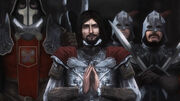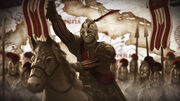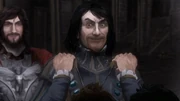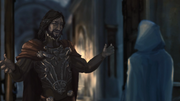(Links and minor rewording) |
(→Plot) |
||
| Line 31: | Line 31: | ||
During the year 1497, Rodrigo's son, [[Juan Borgia the Younger|Juan Borgia]] was named Captain General of the [[Papacy|Papal]] armies, while Cesare was named one of the [[cardinals]]. Not content with the position given to him, Cesare planed to eliminate his brother. With the assistance of the [[courtesan]] [[Fiora Cavazza]], Cesare had his brother killed in bed, and his body subsequently thrown in the [[Tiber River]]. Left with no other substitute, Rodrigo named Cesare the new Captain General. |
During the year 1497, Rodrigo's son, [[Juan Borgia the Younger|Juan Borgia]] was named Captain General of the [[Papacy|Papal]] armies, while Cesare was named one of the [[cardinals]]. Not content with the position given to him, Cesare planed to eliminate his brother. With the assistance of the [[courtesan]] [[Fiora Cavazza]], Cesare had his brother killed in bed, and his body subsequently thrown in the [[Tiber River]]. Left with no other substitute, Rodrigo named Cesare the new Captain General. |
||
| − | Cesare would then begin a conquest for [[Romagna]] in late 1499 with [[Ramiro d'Orco]], [[Oliverotto da Fermo]], and [[Vitellozzo Vitelli]] leading his armies. However, in the midst of their conquest, several of his subjects began to rebel against him. In response, Cesare had Ramiro beheaded and framed his other generals, feeling that he no longer had use for them. Fearing that they could be next, the remaining generals conspired against Cesare, and began a rebellion in the year 1502. The two generals won several battles and even managed to take over several of Cesare's lands. |
+ | Cesare would then begin a conquest for [[Romagna]] in late 1499 with [[Ramiro d'Orco]], [[Oliverotto da Fermo]], and [[Vitellozzo Vitelli]] leading his armies. However, in the midst of their conquest, several of his subjects began to rebel against him. In response, Cesare had Ramiro beheaded and framed his other generals, feeling that he no longer had use for them. Fearing that they could be next, the remaining generals, Oliverotto and Vitellozzo, conspired against Cesare, and began a rebellion in the year 1502. The two generals won several battles and even managed to take over several of Cesare's lands. |
[[File:CesareEzio.png|thumb|250px|Ezio vowed to kill Cesare, no matter the odds.]] |
[[File:CesareEzio.png|thumb|250px|Ezio vowed to kill Cesare, no matter the odds.]] |
||
Hearing the demands of Oliverotto and Vitellozzo, Cesare promised to accept them all, promising that they will return to his service and their past atrocities forgiven. After a few months, Cesare held a dinner in their honor, though it was later revealed by Cesare to be an ambush, and had the two generals bound. Cesare then ordered [[Micheletto Corella]] to strangle them to death. Reclaiming the lands taken from him, Cesare earned the praise and respect of both his allies and his enemies. |
Hearing the demands of Oliverotto and Vitellozzo, Cesare promised to accept them all, promising that they will return to his service and their past atrocities forgiven. After a few months, Cesare held a dinner in their honor, though it was later revealed by Cesare to be an ambush, and had the two generals bound. Cesare then ordered [[Micheletto Corella]] to strangle them to death. Reclaiming the lands taken from him, Cesare earned the praise and respect of both his allies and his enemies. |
||
Revision as of 11:06, 10 November 2011
Assassins Creed: Ascendance is a short, animated film project created to expand the Assassin's Creed series. It was revealed by UbiWorkshop on November 10, 2010, and was released on November 16, 2010 for PlayStation®Store, Xbox LIVE®, and iTunes.[1]
Created as a bridge between Assassin's Creed II and Assassin's Creed: Brotherhood, the short film details more of Cesare Borgia's rise to power.
Plot
After the destruction of Monteriggioni in the year 1500, the Assassin Ezio Auditore met with Leonardo da Vinci in the streets of Rome to obtain information about the Pope's son, Cesare Borgia. Forewarned about the man he wishes to know, Ezio wanted to learn more nevertheless. What followed was a relieving of Cesare's ascension to power.
During the year 1497, Rodrigo's son, Juan Borgia was named Captain General of the Papal armies, while Cesare was named one of the cardinals. Not content with the position given to him, Cesare planed to eliminate his brother. With the assistance of the courtesan Fiora Cavazza, Cesare had his brother killed in bed, and his body subsequently thrown in the Tiber River. Left with no other substitute, Rodrigo named Cesare the new Captain General.
Cesare would then begin a conquest for Romagna in late 1499 with Ramiro d'Orco, Oliverotto da Fermo, and Vitellozzo Vitelli leading his armies. However, in the midst of their conquest, several of his subjects began to rebel against him. In response, Cesare had Ramiro beheaded and framed his other generals, feeling that he no longer had use for them. Fearing that they could be next, the remaining generals, Oliverotto and Vitellozzo, conspired against Cesare, and began a rebellion in the year 1502. The two generals won several battles and even managed to take over several of Cesare's lands.
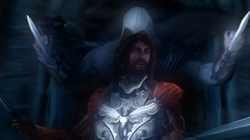
Ezio vowed to kill Cesare, no matter the odds.
Hearing the demands of Oliverotto and Vitellozzo, Cesare promised to accept them all, promising that they will return to his service and their past atrocities forgiven. After a few months, Cesare held a dinner in their honor, though it was later revealed by Cesare to be an ambush, and had the two generals bound. Cesare then ordered Micheletto Corella to strangle them to death. Reclaiming the lands taken from him, Cesare earned the praise and respect of both his allies and his enemies.
By then, Cesare had surrounded himself with several figures of power and talented people, such as Leonardo da Vinci, and several other individuals. Hearing enough, Ezio vows to kill Cesare, despite his reputation. After receiving a scroll from Ezio, Leonardo would return to the side of Cesare in order to resume work on his War Machines. As Leonardo entered the Castel Sant'Angelo, Ezio returns to the city, declaring that Rome's corruption will end.
Media
The art style of the entire animation was made to be a balance between what the animators were comfortable with, and the traditional oil-paint style iconic to the Renaissance era.[2]
Additionally, the makers wished for the film to be familiar to fans of the series. Thus they used sound effects and backgrounds taken directly from Assassin's Creed: Brotherhood, such as the Papal apartments in the Castel Sant'Angelo, and the headquarters on Tiber Island.[2]
Trivia
- The film was originally named "Secret Project Number Three" by UbiWorkshop.[3]
- A variation of Octavian de Valois' death is seen in the introduction of the short film. There, Octavian and several of his men hold Pantasilea Baglioni hostage in the Roman Forum, and is attacked by Ezio, who is wearing his usual Assassin robes. Ezio would then strike from above and stab Octavian wit his hidden blade.
- Octavian's final words also differ from the ones spoken in Assassin's Creed: Brotherhood, saying that he only played a small part in Cesare's plans, rather than him admitting his desire for respect.
- Juan Borgia's murder appears to have taken place in the Tiber Island Hideout. Whether this is considered canon or not is yet to be confirmed.
- The film shows one of the few instances where Cesare is seen using a crossbow, utilizing it to subdue Oliverotto.
- The crossbow Cesare possesses in the film has a unique design, embedded with a small metal sculpture of a woman.
Gallery
Images
Videos
thumb|left|300px|Assassin's Creed: Ascendance Teaser Trailer thumb|300px|right|Assassin's Creed: Ascendance - Making Of
References
- ↑ UbiWorkshop's Assassin's Creed: Ascendance Official Announcement
- ↑ 2.0 2.1 The Making of Assassin's Creed: Ascendance
- ↑ Assassin's Creed: Ascendance teaser

